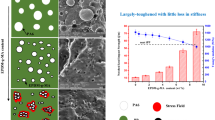Abstract
The fracture behavior of a core-shell rubber (CSR) modified cross-linkable epoxy thermoplastic (CET) system, which exhibits high rigidity, highT g, and low crosslink density characteristics, is examined. The toughening mechanisms in this modified CET system are found to be cavitation of the CSR particles, followed by formation of extended shear banding around the advancing crack. With an addition of only 5 wt.% CSR, the modified CET possesses a greater than five-fold increase in fracture toughness (G IC) as well as greatly improved fatigue crack propagation resistance properties, with respect to those of the neat resin equivalents. The fracture mechanisms observed under static loading and under fatigue cyclic loading are compared and discussed.
Similar content being viewed by others
References
Yee AF, Pearson RA (1986) J Mater Sci 21:2462
Pearson RA, Yee AF (1986) J Mater Sci 21:2475
Lee H, Neville K (1967) Handbook of Epoxy Resins. McGraw-Hill, New York
Pearson RA, Yee AF (1989) J Mater Sci 24:2571
Bradley WL, Schultz W, Corleto C, Komatsu S (1993) Chap. 3 in Toughened Plastics I — Science and Engineering. Riew CK, Kinloch AJ (eds) Adv Chem Ser, 233, Amer Chem Soc, Washington, DC, p 317
Sue H-J (1991) Polym Eng Sci 31:275
Kinloch, AJ (1989) Chap 3 in Rubber-Toughened Plastics. Riew CK (ed) Adv Chem Ser, 222, Amer Chem Soc, Washington, DC, p 67
Bertram JL, Walker LL, Berman JR, Clarke JA (1986) US Patent 4,594,291
Bauer R (1986) 18th International SAMPE Tech Conf, Oct 7–9
Dewhirst KC (1988) Us Patent 4,786,668
Schultz WL, Portelli GB, Jordan RC, Thompson WL (1988) Polym Preprint 29:136
Bishop MT, Bruza KJ, Laman SA, Lee WM, Woo EP (1992) ACS Polymer Preprints 33(1):362
Covavisaruch S, Robertson RE, Filisko FE (1992) J Mater Sci 27:990
Burton BL, Swartz CA (1987) PMSE, Amer Chem Soc 57:201
Williams JG (1984) Fracture Mechanics of Polymers. John Wiley & Sons, New York
Henton DE, Pickelman DM, Arends CB, Meyer VE (1988) US Patent 4,778,851
Sue H-J, Garcia-Meitin EI, Pickelman DM, Yang PC (1993) Chap 10 in Toughened Plastics I — Science and Engineering. Riew CK, Kinloch AJ (eds) Adv Chem Ser, 233, Amer Chem Soc, Washington, DC, p 259
Sue HJ, Pearson RA, Parker DS, Huang J, Yee AF (1988) Polym Preprint 29:147
Sue H-J (1991) Polym Eng Sci 31:270
Sue H-J, Yee AF, J. Mater Sci 28:2975
ASTM Standard, E399-90
Towers OL (1981) Stress Intensity Factor, Compliance. and Elastic η Factors for Six Geometries. The Welding Institute, Cambridge, England.
ASTM Standard, E647-90
Paris PC (1964) Fatigue — An Interdisciplinary Approach. Proceedings 10th Sagamore Conf, Syracuse Univ Press, Syracuse, New York
Holik AS, Kambour RP, Hobbs SY, Fink DG (1979) Microstruct Sci 7:357
Sue H-J, Garcia-Meitin EI, Burton BL, Garrison CC (1991) J Polym Sci, Polym Phys Ed 29:1623
Nielsen LEJ (1969) J Macromol Sci C 3:69
Timm DC, Ayodeji AJ, Foral RF (1985) Br Polym J 17:227
Sue H-J (1992) J Mater Sci 27:3098
Moloney AC, Kausch HH, Kaiser T, Beer HR (1987) J Mater Sci 22:381
Huang Y, Kinloch AJ (1992) J Mater Sci 27:2763
Huang Y, Kinloch AJ (1992) J Mater Sci Letters 11:484
Sue H-J, Garcia-Meitin EI, Orchard NA (1993) J Polym Sci, Polym Phys Ed 31:595
Parker DS, Sue HJ, Huang J, Yee AF (1990) Polymer 31:2267
Sue H-J, Hoffman DW, unpublished work
Hoffman DK, Arends CB (1987) US Patent 4,708,996
Pearson RA, Yee AF (1991) J Mater Sci 26:3828
Hertzberg RW, Manson JA (1980) ‘Fatigue of Engineering Plastics. Academic Press, New York
Paris PC (1964) Fatigue — An Interdisciplinary Approach, Proceedings 10th Sagamore Conf, Syracuse Univ Press, Syracuse, New York
Karger-Kocsis J, Friedrich K (1992) Colloid Polym Sci 270:549
Ritchie RO, Yu W (1986) Short Crack Effects In Fatigue: A Consequence Of Crack Tip Shielding in Small Fatigue Cracks. Ritchie RO, Lankford J (eds) TMS-AIME, Warrendale, PA
Boyce ME, Argon S, Parks DM (1987) Polymer 28:1680
Sue H-J (1988) Mechanical Modeling and Experimental Observations of Toughened Rigid-Rigid Polymer Alloys. Ph D Thesis, The University of Michigan, Ann Arbor
Yee AF (1986) Modifying Matrix Materials for Tougher Composites in “Toughened Composites” STP 937, Johnston NJ (ed) ASTM, Philadelphia, 383
Author information
Authors and Affiliations
Rights and permissions
About this article
Cite this article
Sue, H.J., Bertram, J.L., Garcia-Meitin, E.I. et al. Fracture behavior of core-shell rubber-modified crosslinkable epoxy thermoplastics. Colloid Polym Sci 272, 456–466 (1994). https://doi.org/10.1007/BF00659459
Received:
Accepted:
Issue Date:
DOI: https://doi.org/10.1007/BF00659459




